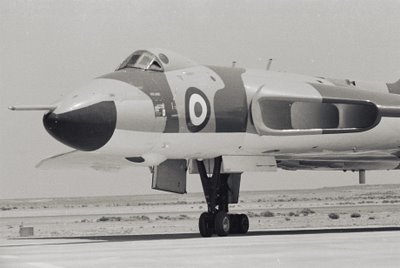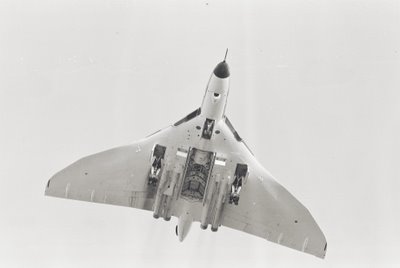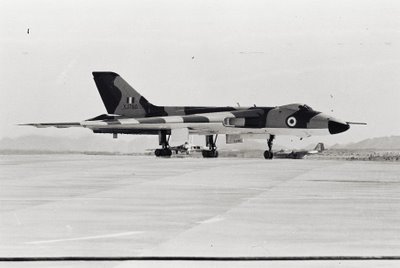Vulcan Part 1

This is an Avro Vulcan, Britain's Cold War bomber.
They were huge aircraft, measuring almost exactly 100 ft long (30.48metres), with a wingspan of 111 feet. They were smelly, dirty and noisy - I worked on them and loved it!!

I'd known the Vulcan ever since I was a boy... After the aircraft began deliveries to the RAF in the mid/late 1950s, Vulcans could be seen almost daily in the sky above my home town in Yorkshire - tiny white triangles coming in at high altitude from the south, and using the distinctive coastline and harbour shape to make practice bombing runs by radar.
There was talk of a *black box* which the crews were supposed to be trying to attack, somewhere near the town. Much later, I learnt EXACTLY how the fabled black box really worked...
In 1966 I joined the Air Force, and in training got my first moderately close-up view of a parked Vulcan at my training station at RAF Cosford, but in 1967 I was posted to a Vulcan station, and finally got *hands-on*!!
But before that, I had a crash course in the black box. What the crews used for training was, in fact a camera, called the R88. It was mounted above the navigator's radar screen, and photographed the screen periodically during a bombing run on long spools of 35mm film.
When the navigator pressed the bomb release, a light came on in the camera, to mark the moment, and the analysts could judge how accurate the dummy attack was.
Remember that in theory the plane was dropping an atomic bomb, so *close enough was good enough*, up to a point.
 My duties, as a photographer, included *doing the R88's*, or in other words developing and printing the films so the crews and the analysts could view them. Sadly, the squadrons that flew from my station never flew over my home town. Instead they spent a lot of time pretending to devastate the industrial city of Scunthorpe, which was probably not a bad thing...
My duties, as a photographer, included *doing the R88's*, or in other words developing and printing the films so the crews and the analysts could view them. Sadly, the squadrons that flew from my station never flew over my home town. Instead they spent a lot of time pretending to devastate the industrial city of Scunthorpe, which was probably not a bad thing...

By October 1967 a new camera, designed to be fitted in the bomb-aimer's position, had been introduced. I'd never seen the particular model before - even in training it was unknown, but it was a good camera, known as the F95 Mk 9. It was mounted vertically over the bomb-aimer's window, and with a wide-angle lens it could cover a large area of ground below the plane on 70mm wide film. Like the R88, it was designed only for analysing bombing, although from time to time crews did take some high altitude pictures...
Part 2 coming soon.......
They were huge aircraft, measuring almost exactly 100 ft long (30.48metres), with a wingspan of 111 feet. They were smelly, dirty and noisy - I worked on them and loved it!!

I'd known the Vulcan ever since I was a boy... After the aircraft began deliveries to the RAF in the mid/late 1950s, Vulcans could be seen almost daily in the sky above my home town in Yorkshire - tiny white triangles coming in at high altitude from the south, and using the distinctive coastline and harbour shape to make practice bombing runs by radar.
There was talk of a *black box* which the crews were supposed to be trying to attack, somewhere near the town. Much later, I learnt EXACTLY how the fabled black box really worked...
In 1966 I joined the Air Force, and in training got my first moderately close-up view of a parked Vulcan at my training station at RAF Cosford, but in 1967 I was posted to a Vulcan station, and finally got *hands-on*!!
But before that, I had a crash course in the black box. What the crews used for training was, in fact a camera, called the R88. It was mounted above the navigator's radar screen, and photographed the screen periodically during a bombing run on long spools of 35mm film.
When the navigator pressed the bomb release, a light came on in the camera, to mark the moment, and the analysts could judge how accurate the dummy attack was.
Remember that in theory the plane was dropping an atomic bomb, so *close enough was good enough*, up to a point.
 My duties, as a photographer, included *doing the R88's*, or in other words developing and printing the films so the crews and the analysts could view them. Sadly, the squadrons that flew from my station never flew over my home town. Instead they spent a lot of time pretending to devastate the industrial city of Scunthorpe, which was probably not a bad thing...
My duties, as a photographer, included *doing the R88's*, or in other words developing and printing the films so the crews and the analysts could view them. Sadly, the squadrons that flew from my station never flew over my home town. Instead they spent a lot of time pretending to devastate the industrial city of Scunthorpe, which was probably not a bad thing...
By October 1967 a new camera, designed to be fitted in the bomb-aimer's position, had been introduced. I'd never seen the particular model before - even in training it was unknown, but it was a good camera, known as the F95 Mk 9. It was mounted vertically over the bomb-aimer's window, and with a wide-angle lens it could cover a large area of ground below the plane on 70mm wide film. Like the R88, it was designed only for analysing bombing, although from time to time crews did take some high altitude pictures...
Part 2 coming soon.......


2 Comments:
kiwi,happy holidays !hope everything is fine !
6's
By Anonymous, at Sun Dec 03, 02:06:00 am NZDT
Anonymous, at Sun Dec 03, 02:06:00 am NZDT
Do you have any more information on the R88 Camera?
Thanks
By Anonymous, at Tue Jul 31, 07:40:00 pm NZST
Anonymous, at Tue Jul 31, 07:40:00 pm NZST
Post a Comment
<< Home